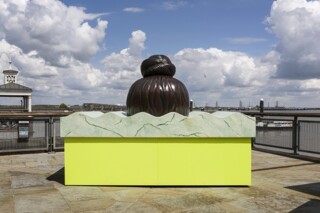Between Land and Sea
Daniel Trilling
Coastal towns in south-east England tend to be portrayed both as bolt-holes for metropolitan creatives priced out of London, and as repositories of a ‘left-behind’ Englishness; two conflicting sets of values that supposedly lie behind one of the defining culture clashes of our age. In Kent in particular, the physical gateway between Britain and Europe, a whole set of political anxieties are being fought out: over lifeboats rescuing migrants from the Channel, or questions of transport and trade. When I drove from London to Gravesend last month, the motorway display boards declared NO FUEL. Other signs pointed to the post-Brexit ‘Inland Border Facility’.
Public art plays a prominent but unresolved role in this story. Are the galleries that have been built in England’s coastal towns in recent years an engine of displacement – of gentrification, or the imposition of cosmopolitan values on a population that supposedly doesn’t want them – or does art play a mediating role, suggesting ways to knit communities together?
Waterfronts was a series of site-specific works that appeared in seven towns in Essex, Kent and Sussex this summer. The artists took ‘the border between land and sea’ as their starting point. Each work was placed close to the shore, responding both to their local surroundings and the larger historical fault lines that run through the towns. On the cliffs at Folkestone, a monumental Janus head by Pilar Quinteros gazed simultaneously inland and out across the Channel. Made of chalk and plaster, it was intended to disintegrate slowly in the open air. At Eastbourne, Mariana Castillo Deball carved a geoglyph into the chalk of the South Downs, in the shape of a hairpin found in the ancient grave of a ‘Frankish woman’ that was excavated nearby in the 1990s.
On first look, Jasleen Kaur’s sculpture in Gravesend, half of a two-part work entitled The first thing I did was to kiss the ground, appeared to be doing its best to stand out from its surroundings. A fluorescent green oblong nestled at the foot of the town’s pier (the oldest surviving cast-iron pier, a nearby signboard tells you), overlooked by the terrace of the Three Daws, a waterside pub dating to the 15th century. The fluorescent box was topped by faux-marble waves, a head beginning to rise out of them (or sinking into them?), the hair gathered up into a topknot. Its shape – a long rectangular base, with the head making a cupola of sorts – vaguely mirrored the shape of the Tilbury cruise terminal building across the Thames Estuary.
Kaur, born in Glasgow, is the grandchild of Punjabi immigrants to the UK. She says the sculpture was intended to be in part a reminder ‘of another time and place: when migration was welcomed and bound up with rehabilitating a postwar Britain’. Tilbury was where the Empire Windrush docked. But Kaur is also teasing out other local connections. Gravesend is one of the most diverse places in Kent, and home to one of the country’s largest Sikh communities: Punjabis began to settle in the town in the 1950s, mostly to work in the local paper milling industry, or in construction. Today, between 10 and 15 per cent of the town’s population are Sikh, and Gravesend is home to one of the largest Gurdwaras in Europe. In December 2020, when hundreds of lorry drivers were stuck on the M20 after France closed its ports to travel from the UK, volunteers from the Gurdwara distributed meals to the stranded drivers. Kaur’s sculpture is loosely based on the floats made for Sikh religious festivals, while the ‘marble’ waves echo the frontage of the nearby temple.
The second part of the work is an audio recording made with the sound artist Ain Bailey. It emerged from Kaur’s trawling of Gravesend’s library archives, looking for traces left by the town’s immigrant communities, and a collaboration with a local Sikh women’s group, which gives language and music lessons. Over a backdrop of rising and falling white noise – it could be static, or waves on the shore, or flames crackling – we hear the voices of women singing devotional songs, or reading out recipes. The layers of sound accumulate and grow in volume, adding a tanpura drone and tabla rhythm, until they subside again. In situ, at the end of the pier, the piece was intended to merge with the sound of the water, though on the day I visited it was switched off. A sign nearby informed visitors that the ferry to Tilbury had been suspended ‘until further notice’.
In Margate, Michael Rakowitz’s life-sized statue of a British Iraq war veteran looked as if it had marched out of the sea, pointing an accusing finger towards Westminster. April is the cruellest month – it was next to the beach shelter where T.S. Eliot wrote part of The Waste Land – is a cast of Daniel Taylor, who now campaigns with Veterans for Peace. There was a quotation from Siegfried Sassoon on the plinth. It was defaced with paint earlier this year. Yet it was also embedded with ‘votive objects’ – items with personal stories attached to them – donated by local residents, gathered at workshops before the pandemic.
Kaur’s work sits more gently – bright but welcoming – in a landscape littered with the detritus of empire, trade and migration. This stretch of the waterfront is known as Gordon Promenade; the general who died at Khartoum in 1885 lived for a while in Gravesend. When I visited it was playing host to both a basketball match, on a court branded with the 2012 Olympic logo, and a Second World War-themed concert. The sculpture’s positioning, on a small triangle of land between the pier and the shoreline, right on the water’s edge, and the audio’s focus on the domestic, hint at the ways people must carve out space to live, even as they are pushed and pulled by forces largely beyond their control.

Comments